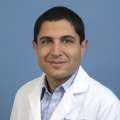Pectus Excavatum and Carinatum Repair
Find your care
UCLA Health pediatric surgeons specialize in delivering outstanding surgical care to every child. Call to connect with an expert.
World-class care for children with chest wall deformities
UCLA Mattel Children's Hospital is a leading center for treating chest deformities. We provide care for patients from Southern California, across the United States, and around the world. For the best results, we usually recommend surgical correction of chest deformities during early adolescence. This timing helps reduce the chance of the condition coming back later in life.
Understanding pectus deformities
Pectus deformities occur due to unusual growth of the rib cartilage, which can cause the chest to either sink inward or stick out. There are two main types of pectus deformities:

- Pectus excavatum: Often called "sunken chest syndrome" or "funnel chest," this condition happens when the front of the chest, including the ribs and breastbone (sternum), sinks inward, creating a sunken appearance.
- Pectus carinatum: Also known as "pigeon chest," this condition is when the chest wall sticks out more than usual, making the chest look protruding.
These conditions are more common than many realize, affecting about 1 in 300 people. While chest deformities may be visible at birth, they often become more noticeable during puberty. The severity can range from mild to severe. In moderate to severe cases, the rib cage may press against the heart and lungs, causing chest pain, breathing difficulties, fatigue, and reduced exercise tolerance.
Evaluation and diagnosis of pectus deformities
To evaluate pectus deformities, doctors commonly use chest X-rays (both front and side views) or a chest CT scan. To reduce radiation exposure, the severity of the deformity can often be assessed with just X-rays. This is done using measurements like the pectus severity index or Haller index.
Additional tests may include:
- Pulmonary function tests: To check how well the lungs are working.
- Echocardiogram: An ultrasound of the heart to assess its function and structure.
When is surgery recommended?
Surgery is typically recommended for moderate to severe pectus deformities, especially if the Haller index (a measurement of the chest’s shape) is greater than 3.2. For reference, a normal Haller index is around 2.5. Surgery may also be considered if the patient has symptoms related to their condition.
If there are signs of connective tissue disorders, patients may be referred to the UCLA Marfan's Clinic for additional evaluation and specialized care.
Surgical procedures for pectus excavatum and carinatum repair
Ravitch procedure (open or modified)
The Ravitch procedure is a well-established surgical method for correcting chest wall deformities. Dr. Eric W. Fonkalsrud, Professor Emeritus at UCLA, improved this method to reduce the amount of cartilage removed, make it easier to reshape the chest wall, and achieve better results.
Procedure details
- An incision is made across the chest, just below the nipples.
- The deformed cartilage is removed, and the sternum is gently adjusted and repositioned.
- A supportive bar is placed to help hold everything in the correct position as it heals.
Recovery details
- The recovery period includes a hospital stay of 3 to 5 days.
- The stabilizing bar is usually removed after about 6 months. By then, new cartilage will have formed to help support the sternum and ribs.
Nuss procedure (minimally invasive)
The Nuss procedure is a newer method for correcting pectus excavatum. Developed by Dr. Donald Nuss and introduced in 1998, this technique has become very popular for treating this condition. After ten years of research and experience, Dr. Nuss shared his findings, leading to the widespread use of this method. Today, the Nuss procedure is the most commonly chosen treatment for pectus excavatum.
Procedure details
- Two small cuts, each about 1 inch long, are made on either side of the rib cage.
- A curved, titanium bar is carefully placed through these cuts and positioned under the sternum (breastbone).
- A small camera is used to allow the surgeons to see and protect the organs inside the chest.
- Cryoablation of the nerves is performed to relax the chest so it remodels and heals with minimal pain.
- The bar is rotated to press against the chest wall, pushing the ribs and sternum outward, similar to how braces help realign teeth.
- Cartilage or bone is usually not removed during this procedure.
- The bar is secured with stitches and stays in place for 2 to 3 years to help reshape the chest.
Recovery details
- The chest deformity is corrected right away.
- The Nuss procedure is usually quicker than the Ravitch procedure. It leads to less blood loss, smaller incisions, and minimal scarring.
- Recovery time is faster than traditional methods, with a usual hospital stay of 1 to 2 days.
- The bar is removed in a brief outpatient procedure once the chest has fully healed.
Contact us
Appointments: | Fax: (310) 206-1120






